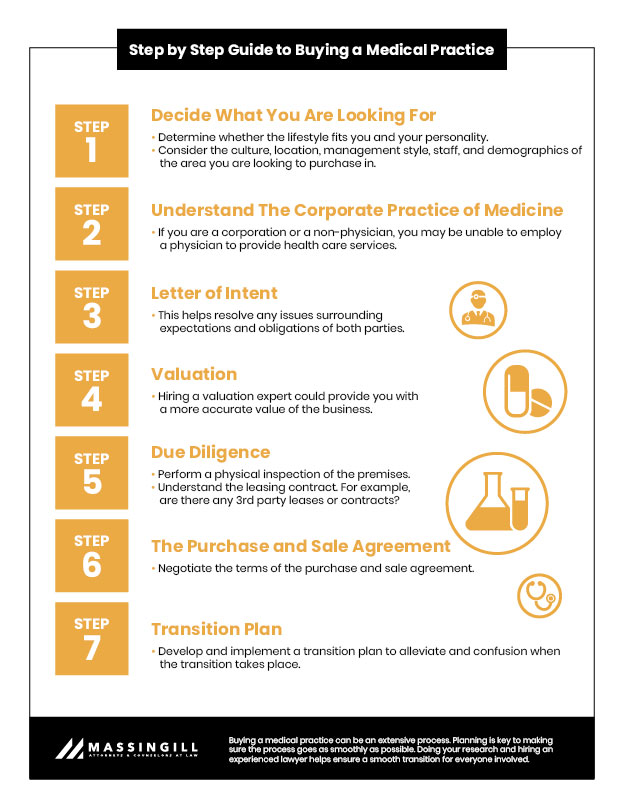
This is a step-by-step guide on How to Buy a Medical Practice in Texas. Purchasing a practice is an incredible undertaking and a complex process. In this guide, you will learn how to acquire a medical practice and better understand the factors you should consider before making a final buying decision.
Whether you want to expand your current practice or go completely solo, there are many practical, legal, and financial considerations. Our guide is intended to help you navigate this purchasing process.
Related Article: How to Sell a Medical Practice in 2024 [Step by Step]
If you are in the process of purchasing a medical practice, having an experience lawyer who understands the process can save time and cost. Please send us a message or call (512) 410-0343 today if you have any questions.
Decide What You Are Looking For
When considering a practice to purchase, you need to determine whether it fits your lifestyle and personality, not just your medical expertise.
Here are some important considerations:
- Culture—do you see yourself working in that kind of atmosphere?
- Location—are you happy with the location of the practice, from the neighborhood to the actual building itself?
- Management style—are the services, policies, practices, and procedures within your skillset and something you are comfortable with?
- Staff—will the staff remain with the practice, or will you have to hire new employees?
- Patients—are the current patients the demographic you are comfortable providing medical care to long term?
You also need to know whether you want a stock purchase or asset purchase. In a stock purchase, the buyer takes full ownership of the entire practice, including all assets and liabilities.
In an asset purchase, the buyer purchases only certain assets, such as customer accounts, medical equipment, and services contracts. There are significant legal and tax consequences to both options.
An experienced Texas healthcare attorney can walk you through both purchase types and make recommendations based on your goals.

Corporate Practice of Medicine
There are limitations on who can practice medicine and provide medical services.
The Corporate Practice of Medicine (CPOM) is a legal doctrine that protects patients from the commercialization of medicine. Creators of the CPOM feared that health care providers would make decisions based on increasing profits as opposed to providing quality care.
Under Texas’s CPOM doctrine, unless they meet an exception, corporations and business entities cannot practice medicine in the state. Additionally, corporations and non-physicians cannot employ a physician to provide health care services in Texas.
The CPOM is applicable when choosing how to structure the purchase of a medical practice. If the transaction is an asset purchase, you need to select an entity type that will be buying the assets. This entity must comply with the CPOM.
Letter of Intent
Once you choose a medical practice to purchase, you may consider agreeing to a non-binding letter of intent. The letter memorializes certain expectations and obligations of the parties. It is also a way to preliminarily resolve issues before going further into the purchase process.
A comprehensive letter of intent sets the groundwork for the purchase agreement.
Valuation
The practice’s valuation is at the center of most negotiations in the purchase of a medical practice. Appraisers use the fair market value standard, which is the price that results from a bargained-for exchange between a willing, informed buyer and a willing, informed seller.
It is best to hire your own valuation expert to confirm the seller’s value of the practice. Do not blindly agree to the seller’s valuation. The seller’s broker may inflate the valuation because most brokers are commission-based, so they have an incentive to increase the value.
Additionally, medical practice owners often include their sweat equity in the valuation. When you work with an appraiser, as a neutral party, he or she can provide a more accurate valuation.
Due Diligence
Due diligence is an investigation of the facts and details of a company. The buyer’s due diligence process is more extensive than the seller’s.
For the purchase of a medical practice, the buyer’s due diligence typically requires a review of the following:
- Financial statements
- Assets
- Books and records
- Tax returns
- Accounts receivable
- Personnel files
- Employee agreements
- Patient charts
- Insurance policies
- List of creditors
The buyer will also want to perform a physical inspection of the premises where the medical practice is located. The building and premises should be in compliance with all applicable building and zoning ordinances,
For any third-party leases or contracts belonging to the medical practice, the buyer should know which contracts are assignable. Some contracts are essential to the operation of the practice, so the buyer will want to include those as part of the purchase. Examples include equipment and services contracts, real estate leases, software licenses, and marketing and advertising agreements. The most important contract is the real estate lease. Do not make assumptions about the property on which the practice is located. It is best to negotiate a new lease with the landlord, which may be as simple as the seller assigning his interest to the buyer.
Another part of the due diligence process is conducting a search on the medical practice as an entity and the principal owners to learn of any liens or lawsuits. This information will help you spot potential risks and give you tools to negotiate a fair purchase price and sale terms of the medical practice.
Lastly, the buyer should ensure that the practice is in compliance with all applicable state and federal healthcare laws and regulations. An experienced healthcare business attorney will be invaluable at this stage based on the volume of information to be evaluated.
The Purchase and Sale Agreement
Once all due diligence is complete, the parties will negotiate the terms of a purchase and sale agreement to finalize the transaction. This document encompasses all due diligence findings, negotiations between the parties, and legal responsibilities and obligations.
Basic Terms
As with any contract, the purchase and sale agreement will have basic provisions regarding the sale, like what is being sold, the type of sale, and the sale terms.
Some of these terms might include:
- Consideration,
- Purchase price,
- Time limits on financing,
- Important dates, and
- Consequences of failure to secure financing.
The parties must fairly negotiate the purchase and ensure it is in compliance with federal laws and regulations.
For example, the Stark Law, the Anti-Kickback Statute, and the Private Inurement Statute all apply to the sale of a medical practice between a physician and a larger physician practice, hospital, or healthcare system.
Warranties and Representations
Both parties will make certain warranties and representations within the purchase and sale agreement. These are statements of fact that both the buyer and seller are warranting to be true. For instance, the seller warrants that the medical practice has no outstanding tax obligations, and the buyer warrants he or she has a license to practice medicine.
To protect both parties, the agreement will contain indemnification clauses. For example, if the seller claims he or she has good title to the building where the medical practice operates, but through due diligence you learn there is an encumbrance, an indemnification clause would protect you against liability.
List of Assets and Liabilities
The purchase and sale agreement should include a schedule of all the medical practice’s assets and liabilities. Everything from office furniture to maintenance service contracts should be included on the list.
The sale of a medical practice does not typically include the following assets:
- Real property,
- Accounts receivable,
- Bank accounts,
- Pension funds, or
- Insurance proceeds and their cash value.
You will want to clearly identify who owns each asset and who is assuming each liability. The agreement should also include an indemnification clause to release the seller from any obligation regarding a liability assumed by the buyer.
Non-Compete Clause
If the selling physician intends to continue practicing and remain geographically close to the medical practice, the agreement should have a non-compete clause.
You can either have a separate non-compete agreement or include a restrictive covenant within the purchase agreement. The enforceability of non-compete agreements varies based on the state. In Texas, a non-compete agreement is enforceable if there is valid consideration and the time, geographic scope, and restricted activities are reasonable.
Termination Provisions
In the event the sale cannot be consummated, you want the ability to terminate the transaction.
The agreement should include a termination provision with a drop-dead date by which a party must elect to terminate the transaction, unless the parties otherwise mutually agree in writing. Upon termination, any funds and documents should be returned and both parties released from further obligation.
Medical Records and Patient Notification
Special consideration must be given to the handling of patient medical records.
Medical records can be transferred to another physician only with the patient’s consent. Patients have the legal right to choose another physician and have a copy of their medical records sent to their physician of choice. Both parties must decide who will handle the medical records and how to manage them, whether by retaining, destroying, or transferring the records.
The parties’ decision must be compliant with state medical record retention laws. In Texas, a physician must retain medical records of adult patients for seven years from the date of the last treatment by that physician.
Lastly, the buyer and seller need to determine who will notify the patients of the change in ownership. This responsibility should be written into the purchase agreement.
Transition Plan
When taking over a medical practice, you should do your best to alleviate any stress, tension, and confusion when the transition takes place. You want patients and employees to be satisfied and stay with the practice. Being unfamiliar with the culture and processes could negatively impact the overall motivation and confidence of the current staff. To get ahead of this, you and the seller should develop and implement a transition plan to introduce the new leadership.
For example, you could present a new employee handbook that sets the expectations of the staff. There could also be a period of overlap where the seller stays involved to introduce you to patients. Whether buying a practice where you currently work or coming in as an outsider, you should create a plan to ensure a smooth changeover.
Contact a Healthcare Attorney
Contact the Austin, Texas healthcare attorneys at Massingill to learn more about how to buy a medical practice.
We have years of experience providing legal representation to health care professionals in Texas, and our attorneys have received over 150 five-star ratings.
Contact us or give us a call at (512) 410-0343 to schedule a consultation.

